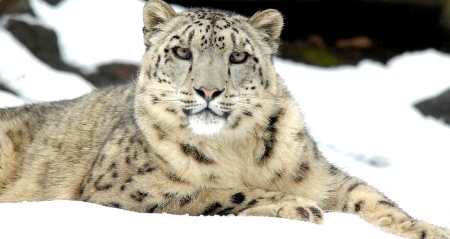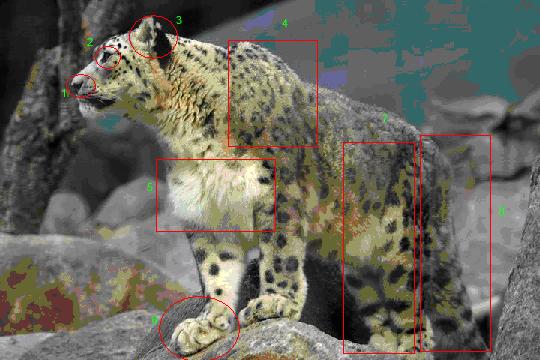Adaptation
 Snow leopards are amazing creatures that are very well suited for their
environment.
Numerous parts of their body are specialized for the
particularly cold rugged mountains in which they live. The picture below
includes circles and rectangles inclosing regions of the cat’s body that
are specific adaptations that help the snow leopard thrive in its
environment. Besides the selected regions of the body that are explained
below in detail snow leopards fur coloring aids as a disguise. The fur
colors and spotting help blend the snow leopard into it’s environment
allowing them to escape being seen from humans and better stalk prey.
Snow leopards are amazing creatures that are very well suited for their
environment.
Numerous parts of their body are specialized for the
particularly cold rugged mountains in which they live. The picture below
includes circles and rectangles inclosing regions of the cat’s body that
are specific adaptations that help the snow leopard thrive in its
environment. Besides the selected regions of the body that are explained
below in detail snow leopards fur coloring aids as a disguise. The fur
colors and spotting help blend the snow leopard into it’s environment
allowing them to escape being seen from humans and better stalk prey.
Region 1- (the nasal cavity) - snow leopards have a deep nasal cavity
and a large chest which helps the animal breath at the high altitudes.
Not only, is the nasal cavity deep but it also has specialized sinus
passages which warms the cold air before it enters the lungs.
Region 2- (eyes)- snow leopards have great eye sight, with the ability
to see six times better than humans can. Their magnificent eye sight
allows them to more easily spot prey.
Region 3- (ears)- These cats have rather small ears which have the
ability to flatten out making it easier to conceal themselves behind
rocks to stalk prey. These small ears also let less heat escape from
their bodies allowing them to stay warmer.
Region 4- (shoulders)- snow leopards have incredibly strong shoulders
muscles that help them climb the steep cliffs and big rocks that cover
their habitat.
Region 5- (fur on underbelly)- the fur seen on the underbelly of a snow
leopard can reach up to 3 inches long. This long hair forms a wooly
undercoat which traps heat and keeps the cat warm.
Region 6- (paws)- The front paws of the snow leopard are large than
those in back. These big “snow shoes” help the snow leopard from falling
through soft snow.
 The pads on the paws are very thick and covered with
fur to aid in warmth and friction to keep them steady. The combination
of thickly padded paws and fur also keeps the snow leopard’s paws from
being hurt by the sharp rocks.
The pads on the paws are very thick and covered with
fur to aid in warmth and friction to keep them steady. The combination
of thickly padded paws and fur also keeps the snow leopard’s paws from
being hurt by the sharp rocks.
Region 7- (hind legs)- The hind legs of these cats are very muscular.
Strong hind legs are necessary to complete wide jumps between ledges.
Due to these powerful legs snow leopards are able to jump a distance of
45 feet from one ledge to another.
Region 8- (tail)- These cats are different from other cats in that it’s
muscular tail can be the length of it’s body. The tail acts as a ruttier
for the cat helping with balance. When the tail it not being used in
balance it aids in warmth. When a snow leopard rests it wraps the long
fluffy tail around it’s body to keep warm.
Watch how the snow leopard uses it's powerful hind legs!

